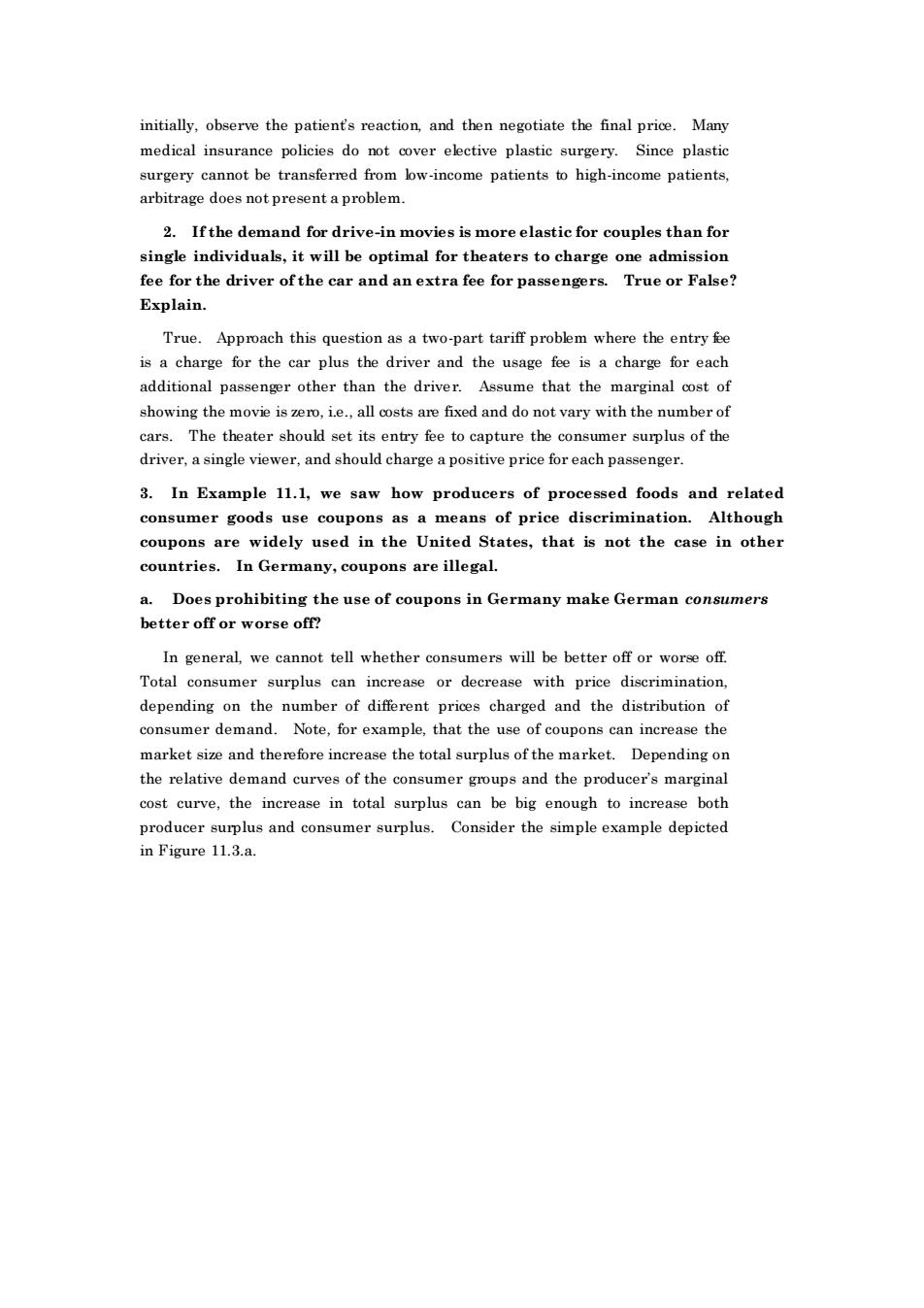正在加载图片...

initially,observe the patient's reaction,and then negotiate the final price.Many medical insurance policies do not over elective plastic surgery.Since plasti surgery cannot be transferred from low-income patients to high-income patients, arbitrage does not present a problem. 2.Ifthe demand for drive-in movies is more elastic for couples than for single individuals,it will be optimal for theaters to charge one admission fee for the driver ofthe car and an extra fee for passengers.True or False? Explain. is a charge for the car plus the driver and the usage fee is a charge for each additional passenger other than the driver.Assume that the marginal cost of showing the movie is zero,i.e.,all costs are fixed and do not vary with the number of cars.The theater should set its entry fee to capture the consumer surplus of the driver.a single viewer,and should charge a positive price for each passenger. 3.In Example 11.1,we saw how producers of processed foods and related consumer goods use coupons asa means of price diserimination.Although coupons are widely used in the United States,that is not the case in other countries.In Germany,coupons are illegal. a.Does prohibiting the use of coupons in Germany make German consumers better off or worse off? In general.we cannot tell whether consumers will be better off or worse off Total umer surplus can e or decre with price discrimination depending on th number of different price charged and the o consumer demand Note,for example,that the use of coupons can increase the market size and therefore increase the total surplus of the market.Depending on the relative demand curves of the consumer groups and the producer's marginal eost curve,the increase in total surplus can be big enough to incre ase both pr ducer surplus and consumer surplus. Consider the simple example depicte in Figure 11.3.a.initially, observe the patient’s reaction, and then negotiate the final price. Many medical insurance policies do not cover elective plastic surgery. Since plastic surgery cannot be transferred from low-income patients to high-income patients, arbitrage does not present a problem. 2. If the demand for drive-in movies is more elastic for couples than for single individuals, it will be optimal for theaters to charge one admission fee for the driver of the car and an extra fee for passengers. True or False? Explain. True. Approach this question as a two-part tariff problem where the entry fee is a charge for the car plus the driver and the usage fee is a charge for each additional passenger other than the driver. Assume that the marginal cost of showing the movie is zero, i.e., all costs are fixed and do not vary with the number of cars. The theater should set its entry fee to capture the consumer surplus of the driver, a single viewer, and should charge a positive price for each passenger. 3. In Example 11.1, we saw how producers of processed foods and related consumer goods use coupons as a means of price discrimination. Although coupons are widely used in the United States, that is not the case in other countries. In Germany, coupons are illegal. a. Does prohibiting the use of coupons in Germany make German consumers better off or worse off? In general, we cannot tell whether consumers will be better off or worse off. Total consumer surplus can increase or decrease with price discrimination, depending on the number of different prices charged and the distribution of consumer demand. Note, for example, that the use of coupons can increase the market size and therefore increase the total surplus of the market. Depending on the relative demand curves of the consumer groups and the producer’s marginal cost curve, the increase in total surplus can be big enough to increase both producer surplus and consumer surplus. Consider the simple example depicted in Figure 11.3.a